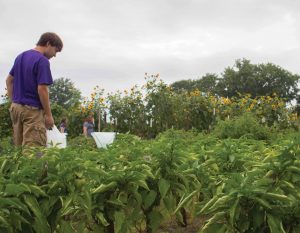UNI hosts sixth annual Harvest Festival
Sep 6, 2018
Despite the overcast sky, a crowd gathered from 5 to 7 p.m. on Thursday, August 30 at the student-run Panther Plot for the sixth annual UNI Harvest Festival.
University Sustainability Coordinator Eric O’Brien kicked off the festival with a few words about the garden before encouraging the students, faculty and community members to enjoy the free food and live music.
Patches of sunflowers towered above the guests and the neat rows of vegetables were labeled with purple and yellow-painted rocks. The paths through the plot were filled with patrons tasting a variety of foods and drinks, such as Mexican street corn, mini vegetable tarts, homestyle potato chips, strawberry iced tea and basil lemonade. Most of the produce used in the food and beverages served was provided by the plot itself. Guests were also able to pick some of the produce and flowers to take home.
The Panther Plot has generated over 3,000 pounds of produce so far this year. Approximately half of that amount has been tomatoes, which—according to O’Brien—is no surprise because about one-sixth of the garden is dedicated to tomatoes each year.
“So far this year we’ve had nearly 1,500 pounds of tomatoes alone that we are able to harvest and take to […] the local dining center here on campus or local businesses,” O’Brien said.
Tomatoes are far from the only produce grown in the garden, which also provides several varieties of sweet corn, peas, green beans, tomatillos, strawberries, herbs and peppers of all colors.
O’Brien explained that the most popular colors of peppers are Panther colors.
“Any time we can do purple and yellow, we try to do purple and yellow,” O’Brien said. “People love when we do that.”
One of the student gardeners, Emily Nelson, was excited about the potatoes, carrots and onions that they planted this year. Nelson also liked being able to work with beets and radishes for the first time.
O’Brien said students enjoy the opportunity to work with produce they might not usually have the opportunity to work with.
This past summer there were about twenty volunteers who worked in the garden. It took approximately 60 hours to maintain the plot.
“During the summer, we would come in everyday, in the morning, from about 7:30 until about one in the afternoon,” said Nelson. “Now we come in twice a week to harvest.”
Nelson also mentioned that the Panther Plot composts the waste it generates. However, there wasn’t much waste this year because they donated some of their produce to the Northeast Iowa Food Bank.
The campus organization Green Project is in charge of maintaining the Panther Plot.
“I believe they are the only student organization that is tasked with managing an actual physical place on campus that they run and they are running it like their own business,” O’Brien said. “It’s cool for me to see that.”
One of the biggest challenges the plot faces is the turnover of students, according to O’Brien. Once upperclassmen graduate, younger students aren’t always familiar with the previous students’ vision and begin working towards a new goal instead.
O’Brien emphasized the fact that the Green Project offers leadership opportunities and the Panther Plot can always use more volunteers. For more information about the Panther Plot and volunteering, students can contact O’Brien at [email protected].














